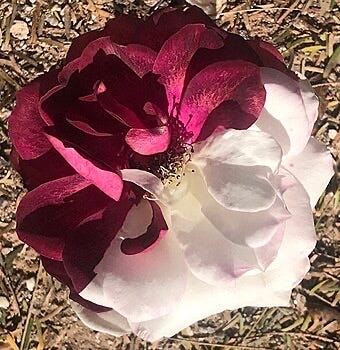Do you love trees? I do. So do Philodendrons. The genus name, Philodendron comes from the Greek philo for love and dendron for tree. For plants native to crowded rainforests, the ability to cling to and climb up a tree to find more light at the top of the forest canopy is pretty useful. And that is exactly how Philodendrons thrive.
This month’s plant, the Philodendron Birkin has never seen a rainforest, however, as it was created in a nursery. Birkins are kind of an accident, actually, caused by what is known as a spontaneous chimeric mutation. I’m going to do my best to explain this, but I’m not a geneticist, or even anything in the neighborhood of a geneticist so… here goes.
Plants mutate pretty easily, and plant mutations are very common. Quite a few varieties of houseplants on the market are the result of mutations. In fact, mutation breeding is a branch of horticulture where seeds are introduced to radiation, just to force mutations. If the resulting mutations are interesting, the plant can be propagated by tissue culture and introduced into the plant trade.
A chimeric mutation is one in which one plant has two genotypes growing within its tissues, the normal one, and a mutated one. If you think of the mythical chimeras it makes a little more sense. Many parts of different animals, but all in one beast.
Chimeras do occur in real animals, generally resulting in a split color variation, like this half-sided parakeet below. Maybe not as rad as the Greek statue above, but still pretty nifty.
Plant chimeras do similar things, like this split color rose below.
Or they can cause variegation in a leaf, where essentially one genotype in the leaf tissue creates cells with chlorophyl that are green and can photosynthesize, and the other genotype doesn’t, so you get leaves that are both white and green. White and green is a typical variegation, but other color combinations do occur. The Philodendron Birkin, is most often white with green pinstripes. The Birkin is a mutated Philodendron Congo Rojo.
Here is my Congo Rojo (still a little battered from my recent move).
And here is my little Birkin, you can see that it has green leaves with white stripes. They’ll get a little more pronounced once it’s grown up a bit. I should I put a warning in here. More light will get you a more striking plant, but direct sun can burn whiter leaves. Grow lights or bright, indirect light are safer.
A plant that has mutated in this way can actually revert to its dominate genotype, like this reverting Birkin below.
I can’t explain how a plant does this, but it is the result of poor light conditions. White leaves or white portions of leaves are useless to a plant as they can’t photosynthesize, thus a plant in poor light will need greener leaves and will revert back to its original form by growing new leaves without the mutation. It is also possible for a plant to sprout, or become, all white. These plants are unable to feed themselves and usually die unless they are able to parasitize other plants, like this Monotropa uniflora, also known as ghost plant.
This Hoya carnosa variegata ‘tricolor’ I have was, up until last week, growing under a grow light. While it was there it sprouted these all pink and white leaves. Completely useless for the plant, but it was getting plenty of light and didn’t need more green leaves, so why not splurge a little?
I don’t at all understand how this happens. Is the plant choosing which genotype to activate depending on the amount of light it gets? Because being able to choose to be a mutant is kind of cool. If anyone reading this knows, I would love to hear from you in the comments. I haven’t been able to find the answer in my research and I’m insanely curious.
So there you go, a little mutant action for this month. There are other kinds of plant mutations so we will definitely be talking about this again in the future.
Thanks for reading!











I always love mutant action. This was a delightful little post full of color that is dearly needed in this odd winter. Love my snake plant, it might be the strongest plant I've had the pleasure to care for.
We have a ghost plant in our backyard. I would post a picture here if I could. They are fascinating!